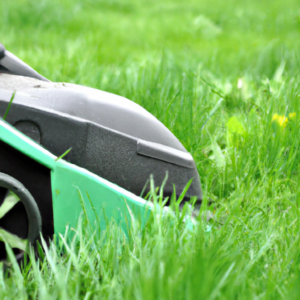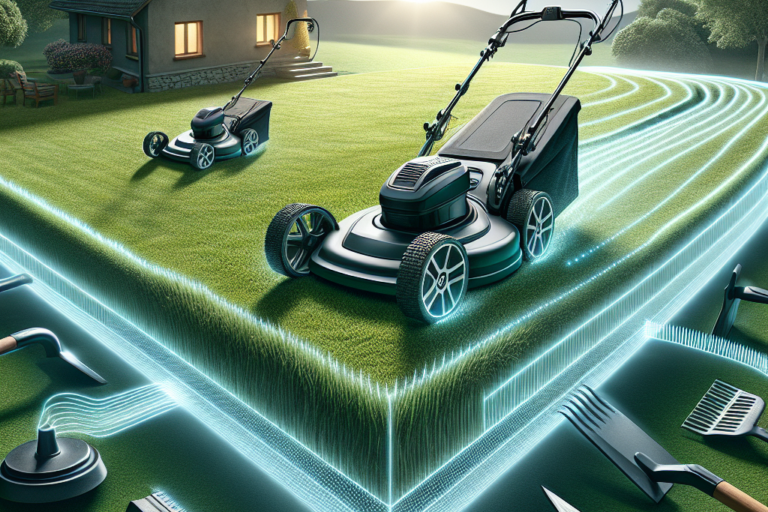Thinking of tackling your tall, overgrown grass but unsure if your electric mower can handle the job? Well, you’re in luck! This article will answer all your burning questions and put your concerns to rest. We’ll explore the capabilities of an electric mower when it comes to tackling those unruly lawns and provide you with some handy tips to ensure a successful mowing experience. So, grab your favorite beverage, sit back, and let’s delve into the world of electric mowers and tall, overgrown grass!
Challenges of using an electric mower for tall, overgrown grass
Limited power compared to gas mowers
Using an electric mower for tall, overgrown grass may present a challenge due to its limited power compared to gas mowers. Electric mowers typically have lower horsepower, which means they may struggle to cut through thick grass efficiently. If the grass is particularly overgrown, you may need to make multiple passes or go over the same area repeatedly to achieve the desired cut. This could result in longer mowing times and potentially a less consistent cut.
Potential damage to the motor
Another challenge when using an electric mower for tall, overgrown grass is the potential for damage to the motor. Electric mowers are not designed to handle extremely tall or dense grass, so forcing the mower through these conditions could put excessive strain on the motor. This could lead to overheating or even permanent damage. It is important to be mindful of the grass height and condition before using an electric mower to avoid any potential motor damage.
Difficulty in maneuvering through dense grass
The dense nature of tall, overgrown grass can also pose a challenge when using an electric mower. Electric mowers may struggle to maneuver through thick grass, making it harder to achieve an even cut. The blades may get bogged down, resulting in an uneven cut or missed areas. It is important to be patient and make deliberate, slow movements when maneuvering through dense grass to avoid damaging the mower or producing an unsightly cut.
Risk of clogging the cutting deck
Clogging the cutting deck is another challenge that may arise when using an electric mower for tall, overgrown grass. If the grass is excessively long or wet, it can accumulate in the cutting deck, obstructing the blades and preventing proper cutting. This not only reduces cutting efficiency but also increases the risk of damaging the mower’s motor. It is crucial to regularly clear out any grass clippings or debris from the cutting deck to prevent clogging and ensure optimal performance.
Preparation steps before cutting tall, overgrown grass
Clearing the area of debris and obstacles
Before you start mowing tall, overgrown grass with an electric mower, it is important to clear the area of any debris and obstacles. Remove any large rocks, branches, or other objects that could damage the mower or impede its movement. Inspect the area for any hidden obstacles, such as hidden tree stumps or uneven terrain, to ensure a smooth and safe mowing experience.
Lowering the cutting height gradually
To avoid overwhelming the electric mower and achieve a clean cut, it is recommended to lower the cutting height gradually when dealing with tall, overgrown grass. Start with a high cutting height setting and gradually reduce it with each subsequent mowing pass. This helps ease the strain on the motor and allows the mower to cut through the grass more effectively. Avoid trying to cut the grass too short in a single pass, as this can overload the mower and result in an unsatisfactory cut.
Moistening the grass if it is too dry
Electric mowers tend to perform better when the grass is slightly moist compared to dry, brittle grass. If the tall, overgrown grass is dry, it may be beneficial to moisten it slightly before mowing. This can be done by lightly watering the area a few hours before mowing. However, be careful not to water the grass excessively, as overly wet grass can also cause clogging in the cutting deck and lead to other issues.
Using a brush cutter for initial trimming
If the tall, overgrown grass is particularly dense or tangled, using a brush cutter or a string trimmer can be helpful for initial trimming. These tools are designed to handle thicker vegetation and can make it easier to tackle tough spots before using the electric mower. Using a brush cutter or a string trimmer to clear any excessively tall or dense areas will make the mowing process smoother and more efficient.

Tips for cutting tall, overgrown grass with an electric mower
Start with a higher cutting height
When mowing tall, overgrown grass with an electric mower, it is best to start with a higher cutting height. This allows the mower to tackle the grass in manageable increments, reducing strain on the motor and creating a more even cut. As the grass gets shorter with each pass, gradually lower the cutting height to achieve the desired length. Starting with a higher cutting height also helps prevent the mower from getting bogged down or clogged in dense grass.
Take it slow and make multiple passes
To achieve a clean and even cut on tall, overgrown grass, it is important to take it slow and make multiple passes. Rushing through the mowing process can result in missed spots and an uneven cut. By moving at a steady pace and overlapping each pass slightly, you ensure that all areas of the grass are evenly trimmed. Taking your time will also prevent the electric mower from becoming overwhelmed and potentially stalling or damaging the motor.
Use a side discharge option
When mowing tall, overgrown grass, using a side discharge option on the electric mower can be beneficial. A side discharge chute allows the cut grass to be expelled out the side of the mower, reducing the risk of clogging in the cutting deck. This is especially helpful when dealing with longer or denser grass conditions. However, be mindful of the direction in which the grass clippings are being discharged to avoid throwing them into unwanted areas, like flower beds or walkways.
Avoid cutting wet grass
It is generally recommended to avoid cutting wet grass with an electric mower, regardless of the grass height or condition. Wet grass has a tendency to clump together and stick to the cutting deck, resulting in clogging and potentially damaging the motor. If the grass is wet, it is advisable to wait for it to dry before mowing. Cutting wet grass can also result in an uneven cut and contribute to the spread of diseases among the grass blades. Patience is key when it comes to mowing wet grass.
Clean the cutting deck frequently
To prevent clogging and maintain the performance of the electric mower, it is essential to clean the cutting deck frequently when cutting tall, overgrown grass. Grass clippings, debris, and dirt can accumulate in the cutting deck, obstructing the blades and impeding their ability to cut effectively. Regularly stop the mower and use a brush or a garden hose to remove any debris from the cutting deck. This will help ensure optimal cutting performance and prolong the longevity of the electric mower.
Benefits of using an electric mower for tall, overgrown grass
Environmentally friendly
One of the major benefits of using an electric mower for tall, overgrown grass is its environmental friendliness. Electric mowers produce zero emissions compared to gas mowers, which contribute to air pollution and greenhouse gas emissions. By opting for an electric mower, you are reducing your carbon footprint and helping to protect the environment.
Low maintenance and easy to use
Electric mowers are known for their low maintenance requirements and user-friendly design, making them a convenient choice for tackling tall, overgrown grass. Unlike gas mowers, electric mowers do not require oil changes, spark plug replacements, or air filter cleanings. They are also easier to start, typically requiring a simple push-button or pull lever. Additionally, electric mowers are lighter and more compact, making them easier to maneuver through challenging terrain or tight spaces.
Quieter operation
Another advantage of electric mowers is their quieter operation compared to gas mowers. Gas mowers tend to be noisy and can cause disturbances for you and your neighbors. In contrast, electric mowers produce significantly less noise, allowing for a more peaceful mowing experience. This can be particularly beneficial if you live in a residential area or have noise restrictions in place.
No need for gas or oil
Using an electric mower eliminates the need for gas or oil, which not only saves you money but also eliminates the hassle of refueling and the risk of spills or leaks. Gas mowers require regular fuel purchases and oil changes, which can add up over time. Electric mowers operate solely on electricity, so as long as you have a charged battery, you’re good to go. This convenience and cost-effectiveness make electric mowers a desirable option for cutting tall, overgrown grass.
In conclusion, using an electric mower to cut tall, overgrown grass may present challenges such as limited power compared to gas mowers, potential damage to the motor, difficulty in maneuvering through dense grass, and a risk of clogging the cutting deck. However, with proper preparation steps like clearing the area, gradually lowering the cutting height, moistening the grass if necessary, and using a brush cutter for initial trimming, these challenges can be mitigated. Tips such as starting with a higher cutting height, making multiple passes, using a side discharge option, avoiding cutting wet grass, and regularly cleaning the cutting deck can further enhance the mowing process. Despite the challenges, electric mowers offer benefits such as being environmentally friendly, low maintenance, easy to use, quieter in operation, and eliminating the need for gas or oil. By considering these factors and following the appropriate techniques, you can effectively use an electric mower to tackle tall, overgrown grass with ease and achieve a well-maintained lawn.






